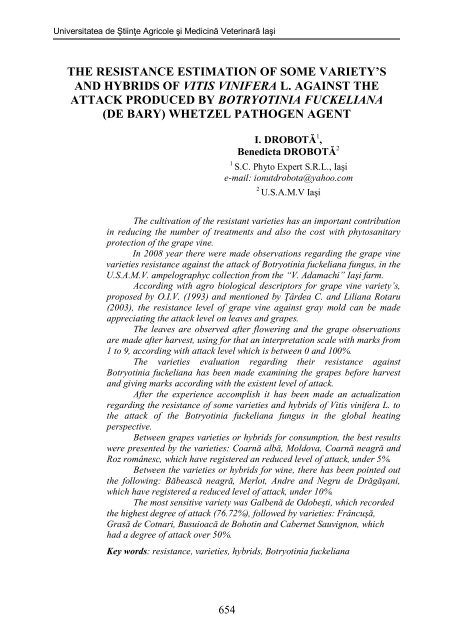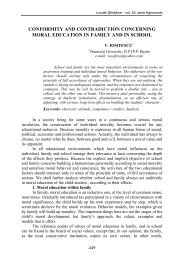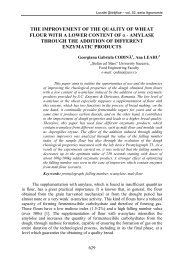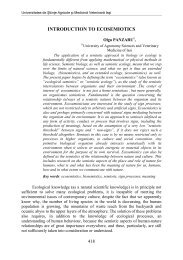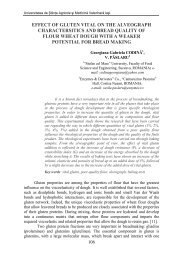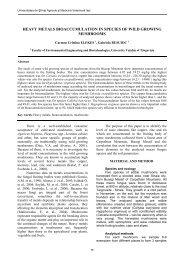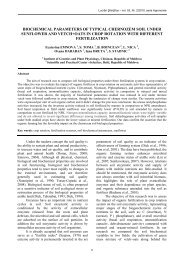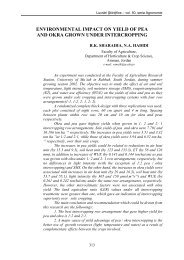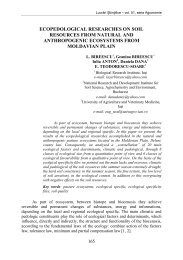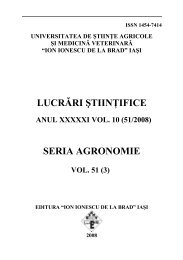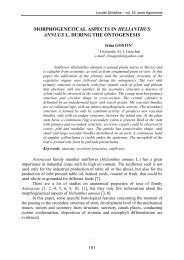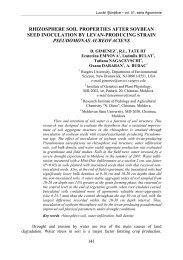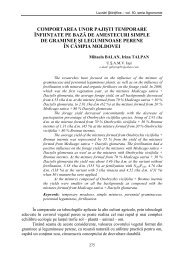the resistance estimation of some variety's and hybrids of vitis ...
the resistance estimation of some variety's and hybrids of vitis ...
the resistance estimation of some variety's and hybrids of vitis ...
Create successful ePaper yourself
Turn your PDF publications into a flip-book with our unique Google optimized e-Paper software.
Universitatea de Ştiinţe Agricole şi Medicină Veterinară Iaşi<br />
THE RESISTANCE ESTIMATION OF SOME VARIETY’S<br />
AND HYBRIDS OF VITIS VINIFERA L. AGAINST THE<br />
ATTACK PRODUCED BY BOTRYOTINIA FUCKELIANA<br />
(DE BARY) WHETZEL PATHOGEN AGENT<br />
I. DROBOTĂ 1 ,<br />
Benedicta DROBOTĂ 2<br />
1<br />
S.C. Phyto Expert S.R.L., Iaşi<br />
e-mail: ionutdrobota@yahoo.com<br />
2<br />
U.S.A.M.V Iaşi<br />
The cultivation <strong>of</strong> <strong>the</strong> resistant varieties has an important contribution<br />
in reducing <strong>the</strong> number <strong>of</strong> treatments <strong>and</strong> also <strong>the</strong> cost with phytosanitary<br />
protection <strong>of</strong> <strong>the</strong> grape vine.<br />
In 2008 year <strong>the</strong>re were made observations regarding <strong>the</strong> grape vine<br />
varieties <strong>resistance</strong> against <strong>the</strong> attack <strong>of</strong> Botryotinia fuckeliana fungus, in <strong>the</strong><br />
U.S.A.M.V. ampelographyc collection from <strong>the</strong> “V. Adamachi” Iaşi farm.<br />
According with agro biological descriptors for grape vine variety’s,<br />
proposed by O.I.V. (1993) <strong>and</strong> mentioned by Ţârdea C. <strong>and</strong> Liliana Rotaru<br />
(2003), <strong>the</strong> <strong>resistance</strong> level <strong>of</strong> grape vine against gray mold can be made<br />
appreciating <strong>the</strong> attack level on leaves <strong>and</strong> grapes.<br />
The leaves are observed after flowering <strong>and</strong> <strong>the</strong> grape observations<br />
are made after harvest, using for that an interpretation scale with marks from<br />
1 to 9, according with attack level which is between 0 <strong>and</strong> 100%.<br />
The varieties evaluation regarding <strong>the</strong>ir <strong>resistance</strong> against<br />
Botryotinia fuckeliana has been made examining <strong>the</strong> grapes before harvest<br />
<strong>and</strong> giving marks according with <strong>the</strong> existent level <strong>of</strong> attack.<br />
After <strong>the</strong> experience accomplish it has been made an actualization<br />
regarding <strong>the</strong> <strong>resistance</strong> <strong>of</strong> <strong>some</strong> varieties <strong>and</strong> <strong>hybrids</strong> <strong>of</strong> Vitis vinifera L. to<br />
<strong>the</strong> attack <strong>of</strong> <strong>the</strong> Botryotinia fuckeliana fungus in <strong>the</strong> global heating<br />
perspective.<br />
Between grapes varieties or <strong>hybrids</strong> for consumption, <strong>the</strong> best results<br />
were presented by <strong>the</strong> varieties: Coarnă albă, Moldova, Coarnă neagră <strong>and</strong><br />
Roz românesc, which have registered an reduced level <strong>of</strong> attack, under 5%.<br />
Between <strong>the</strong> varieties or <strong>hybrids</strong> for wine, <strong>the</strong>re has been pointed out<br />
<strong>the</strong> following: Băbească neagră, Merlot, Andre <strong>and</strong> Negru de Drăgăşani,<br />
which have registered a reduced level <strong>of</strong> attack, under 10%.<br />
The most sensitive variety was Galbenă de Odobeşti, which recorded<br />
<strong>the</strong> highest degree <strong>of</strong> attack (76.72%), followed by varieties: Frâncuşă,<br />
Grasă de Cotnari, Busuioacă de Bohotin <strong>and</strong> Cabernet Sauvignon, which<br />
had a degree <strong>of</strong> attack over 50%.<br />
Key words: <strong>resistance</strong>, varieties, <strong>hybrids</strong>, Botryotinia fuckeliana<br />
654<br />
654
Lucrări Ştiinţifice – vol. 52, seria Agronomie<br />
Assessing <strong>the</strong> varieties <strong>and</strong> <strong>hybrids</strong> behavior <strong>of</strong> grape vine against grey mold<br />
has been achieved among o<strong>the</strong>rs by Torje D. <strong>and</strong> co. in 1980 <strong>and</strong> 1984, mention by<br />
Isabela Ilişescu - 2004. According to <strong>the</strong>se studies, <strong>the</strong> most resistant varieties over<br />
<strong>the</strong> attack <strong>of</strong> Botryotinia fuckeliana fungus are as follows: Coarnă neagră<br />
tămâioasă; Coarnă neagră selecţionată; Victoria; Timpurie de Cluj; Cabernet<br />
Sauvignon 7 Dg.; Cabernet Sauvignon 4 Iş. <strong>and</strong> Aromat de Iaşi.<br />
MATERIAL AND METHOD<br />
For appreciating <strong>the</strong> <strong>resistance</strong> level <strong>of</strong> grape vine against gray mold in <strong>the</strong><br />
ampelographyc collection <strong>of</strong> USAMV Iasi, was used <strong>the</strong> scale proposed by O.I.V.<br />
(1993) <strong>and</strong> mentioned by Ţârdea C. <strong>and</strong> Liliana Rotaru 2003 (table 1).<br />
Table 1<br />
The <strong>resistance</strong> level <strong>of</strong> grapes against Botryotinia fuckeliana fungus (O.I.V. - 1993)<br />
The expression The attack level<br />
Grapes <strong>resistance</strong> <strong>of</strong> gray mold attack<br />
nature<br />
(AL%)<br />
1<br />
>75%<br />
Very poor<br />
2<br />
50 - 75%<br />
3<br />
40 – 50%<br />
Poor (all grapes attacked, <strong>the</strong> grapes are fall)<br />
4<br />
25 – 40%<br />
Middle (up to 20% <strong>of</strong> <strong>the</strong> berries are peaked or<br />
5<br />
15 – 25%<br />
rotting)<br />
6<br />
10 – 15%<br />
7<br />
5 – 10%<br />
Good (only a few berries are peaked or rotting)<br />
8<br />
1 -5%<br />
Very good 9 < 1%<br />
RESULTS AND DISCUSIONS<br />
In 2008, <strong>the</strong>re were made observations regarding <strong>the</strong> grape vine varieties<br />
<strong>resistance</strong> against <strong>the</strong> attack <strong>of</strong> Botryotinia fuckeliana fungus, in <strong>the</strong> U.S.A.M.V.<br />
ampelographyc collection from <strong>the</strong> “V. Adamachi” Iaşi farm.<br />
The varieties evaluation regarding <strong>the</strong>ir <strong>resistance</strong> against Botryotinia<br />
fuckeliana had been made by giving marks according to <strong>the</strong> existent level <strong>of</strong> attack,<br />
as in table 2.<br />
Table 2<br />
The grape vine varieties evaluation regarding <strong>the</strong>ir <strong>resistance</strong> against Botryotinia<br />
fuckeliana, in ampeloraphyc collection from U.S.A.M.V. Iaşi<br />
Varieties/<strong>hybrids</strong> for consumption grapes<br />
655<br />
655<br />
AL%<br />
The expression<br />
nature<br />
The<br />
<strong>resistance</strong> <strong>of</strong><br />
varieties<br />
studied<br />
Soiuri/hibrizi pentru struguri de masa<br />
Chasslas dore 36,26 4 S<br />
Cetăţuia 11,14 6 MR<br />
Coarnă albă 3,96 8 R<br />
Muscat de Hamburg 6,22 7 R<br />
Regina viilor 16,10 5 MR
Universitatea de Ştiinţe Agricole şi Medicină Veterinară Iaşi<br />
Varieties/<strong>hybrids</strong> for winy grapes<br />
AL%<br />
The expression<br />
nature<br />
The <strong>resistance</strong><br />
<strong>of</strong> varieties<br />
studied<br />
Moldova 1,25 8 R<br />
Napoca 7,47<br />
7 R<br />
Afuz ali 9,75 7 R<br />
Coarnă neagră 3,84 8 R<br />
Ceauş 28,39<br />
4 S<br />
Perlă de Csaba 34,18 4 S<br />
Roz românesc 3,32 8 R<br />
Pance D'Espagne 9,07 7 R<br />
Bicane 29,41 4 S<br />
Galbenă de Odobeşti 76,72 1 FS<br />
Aligote 34,66 4 S<br />
Armaş 45,51 3 S<br />
Fetească albă 39,50 4 S<br />
Frâncuşă 55,54 2 FS<br />
Grasă de Cotnari 57,61 2 FS<br />
Pinot gris 24,42 5 MR<br />
Zghihară de Huşi 26,17 4 S<br />
Chardonnay 46,03 3 S<br />
Fetească regală 32,41 4 S<br />
Furmint 38,19 4 S<br />
Muscadele 31,12 4 S<br />
Băbească neagră 3,23 8 R<br />
Busuioacă de Bohotin<br />
52,86<br />
2 FS<br />
Tămâioasă românească 33,19 4 S<br />
Muscat Ottonel 19,34 5 MR<br />
Traminer alb 22,85 4 S<br />
Traminer roz 20,18 5 MR<br />
Riesling italian 17,60 5 MR<br />
Cabernet Sauvignon<br />
60,34<br />
2 FS<br />
Fetească neagră 28,75 4 S<br />
Merlot 9,96 7 R<br />
Pinot Noir 25,01 4 S<br />
Bastard de Magaraci 27,96 4 S<br />
Blauerzweigelt 15,16 5 MR<br />
Negru aromat 11,84 6 MR<br />
Andre 6,04 7 R<br />
Novac 21,22 5 MR<br />
Negru de Drăgăşani<br />
8,33<br />
7 R<br />
Furmint de Miniş 28,74 4 S<br />
656<br />
656
Lucrări Ştiinţifice – vol. 52, seria Agronomie<br />
VR very resistant Without attack or mark 9<br />
R resistant La% = 1 – 10 or marks 7, 8<br />
MR midle resistant La% = 10 – 25 or marks 5, 6<br />
S sensible La% = 25 – 50 or marks 3, 4<br />
FS very sensible La% > 50 or marks 1, 2<br />
CONCLUSIONS<br />
The varieties evaluation regarding <strong>the</strong>ir <strong>resistance</strong> against Botryotinia<br />
fuckeliana has been made examining <strong>the</strong> grapes before harvest <strong>and</strong> giving marks<br />
according with <strong>the</strong> existent level <strong>of</strong> attack.<br />
After <strong>the</strong> accomplishment <strong>of</strong> experience it has been made an actualization<br />
regarding <strong>the</strong> <strong>resistance</strong> <strong>of</strong> <strong>some</strong> varieties <strong>and</strong> <strong>hybrids</strong> <strong>of</strong> Vitis vinifera L. to <strong>the</strong><br />
attack <strong>of</strong> <strong>the</strong> Botryotinia fuckeliana fungus in <strong>the</strong> global heating perspective.<br />
Between <strong>the</strong> varieties or <strong>hybrids</strong> <strong>of</strong> grapes for consumption, <strong>the</strong> best results<br />
were presented by <strong>the</strong> varieties: Coarnă albă, Moldova, Coarnă neagră <strong>and</strong> Roz<br />
românesc, which have registered an reduced level <strong>of</strong> attack, under 5%.<br />
Between <strong>the</strong> varieties or <strong>hybrids</strong> for wine, <strong>the</strong>re had been pointed out <strong>the</strong><br />
following: Băbească neagră, Merlot, Andre şi Negru <strong>and</strong> Drăgăşani, which have<br />
registered a reduced level <strong>of</strong> attack, under 10%.<br />
The most sensitive variety was Galbenă de Odobeşti, which recorded <strong>the</strong><br />
highest degree <strong>of</strong> attack (76.72%), followed by varieties: Frâncuşă, Grasă de<br />
Cotnari, Busuioacă de Bohotin <strong>and</strong> Cabernet Sauvignon, which had a degree <strong>of</strong><br />
attack over 50%.<br />
BIBLIOGRAPHY<br />
1. Galet, P., 1991 – Précis de Pathologie viticole – Montpellier, Franţa.<br />
2. Iacob, Viorica şi colab., 2000 – Fitopatologie horticolă – Editura Ion Ionescu de la Brad –<br />
Iaşi.<br />
3. Ştefan, Aurora, Liliana, 2001 – Botrytis cinerea – agentul etiologic al putregaiului cenuşiu<br />
al strugurilor. I. Parametrii biologici (Surse de nutriţie) A.N. I.C.P.P., Vol. XXXI.<br />
4. Ţârdea, Constantin, Rotaru, Liliana, 2003 – Ampelografie - vol. I. Editura Ion Ionescu de<br />
la Brad – Iaşi.<br />
657<br />
657


